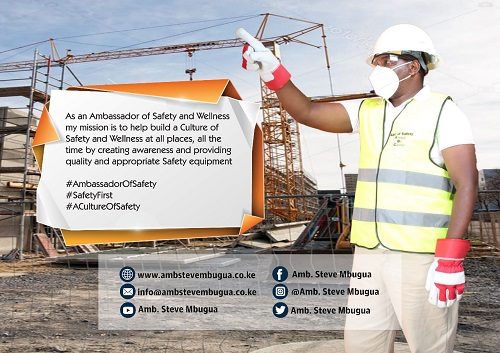Since 2012 as an Ambassador of safety Trainer I have been conducting Safety Professional Trainings as Well as Certified Emergency First Responder rising to highest ranks of Training Manager and Director of training with different agencies like the St John Ambulance Kenya before becoming a fully fledged Ambassador of Safety. I have coordinator dozens of Safety Conferences, Seminars, Workshops and Trainings including having organized the first World Safety Day and First Aid events in Kenya. From my experiences I have prepared the below guideline.
1. Interactive Safety Workshops
o Description: Conduct interactive workshops that involve hands-on activities, role-playing scenarios, and expert-led discussions on specific safety topics. These workshops engage employees actively, encouraging participation and understanding of safety protocols.
o Benefits: Enhances learning through practical experience, promotes teamwork and communication, allows for immediate feedback and clarification of safety procedures.
2. Safety Signage and Posters
o Description: Use clear and informative safety signs, posters, and banners strategically placed throughout the workplace. These visuals serve as constant reminders of safety practices, emergency procedures, hazard warnings, and the location of safety equipment.
o Benefits: Reinforces safety messages visually, aids in hazard recognition and awareness, serves as a quick reference for emergency procedures, and improves overall safety culture.
3. Regular Safety Drills
o Description: Conduct regular safety drills and simulations to practice emergency responses such as fire drills, evacuation drills, or mock medical emergencies. These drills familiarize employees with escape routes, emergency equipment, and proper procedures under stressful conditions.
o Benefits: Prepares employees to react quickly and effectively during real emergencies, identifies areas for improvement in emergency plans, boosts confidence in handling crises, and reduces panic during actual incidents.
4. Safety Newsletters
o Description: Distribute regular safety newsletters containing safety tips, updates on new safety regulations, success stories, incident reports, and reminders about upcoming training sessions or safety events. Newsletters can be in digital or print format.
o Benefits: Keeps safety information current and accessible, reinforces safety knowledge and practices, encourages proactive safety behaviors, and fosters a sense of community around safety initiatives.
5. Safety Incentive Programs
o Description: Implement safety incentive programs to recognize and reward employees for adhering to safety protocols, reporting hazards, suggesting improvements, and actively participating in safety initiatives. Incentives may include awards, recognition ceremonies, bonuses, or other tangible rewards.
o Benefits: Motivates employees to prioritize safety, reinforces positive safety behaviors, boosts morale and engagement, cultivates a culture of safety awareness, and reduces accidents and incidents.
6. Safety Committees
o Description: Form safety committees comprising representatives from various departments or employee groups to regularly review safety practices, discuss safety concerns, and propose improvements. Committees facilitate communication, collaboration, and accountability in safety management.
o Benefits: Provides a forum for addressing safety issues proactively, involves employees in safety decision-making, enhances safety culture through shared responsibility, and ensures diverse perspectives in identifying and mitigating risks.
7. Social Media Campaigns
o Description: Utilize social media platforms (e.g., LinkedIn, Twitter, Facebook) to share safety messages, tips, videos, infographics, and success stories. Engage employees and stakeholders by promoting safety events, campaigns, and initiatives through interactive content.
o Benefits: Reaches a wide audience quickly, especially younger or tech-savvy employees, facilitates sharing of safety information virally, enhances brand reputation as a safety-conscious organization, and encourages community engagement and feedback.
8. Safety Apps
o Description: Promote or develop mobile applications that deliver safety alerts, guidelines, training modules, and emergency notifications directly to employees’ smartphones or tablets. These apps may include interactive features, quizzes, real-time updates, and access to safety resources.
o Benefits: Enhances accessibility to safety information anytime, anywhere, improves engagement with interactive content and notifications, facilitates immediate access to emergency procedures, and supports ongoing safety learning and awareness.
9. Onboarding Safety Training
o Description: Integrate comprehensive safety training into the onboarding process for new employees. Cover essential safety policies, procedures, hazard awareness, emergency protocols, and the use of safety equipment relevant to their roles.
o Benefits: Ensures new hires start with a strong foundation in workplace safety, reduces risks during the learning curve, instills a safety-oriented mindset from the beginning, and promotes compliance with safety standards.
10. Partnerships with Local Authorities
o Description: Collaborate with local safety agencies, fire departments, police, or health services to organize joint training sessions, workshops, or safety awareness campaigns. These partnerships leverage expertise, resources, and local knowledge to enhance safety education and preparedness.
o Benefits: Provides access to specialized safety training and resources, strengthens community relationships and support networks, ensures alignment with local safety regulations and emergency response protocols, and fosters a unified approach to safety within the community.
Educating individuals and organizations about the importance of safety is paramount to fostering a safe and productive environment. Through comprehensive safety awareness, sensitization, and training programs, organizations can significantly reduce the risk of accidents, enhance employee morale, and ensure compliance with regulatory standards. Implementing robust safety practices and obtaining professional certifications further solidifies a culture of safety that benefits both individuals and the organization as a whole.
In conclusion, safety training is a critical component of fostering a secure and prepared environment. Ambassador Steve Mbugua, as a renowned safety ambassador and trainer, emphasizes the importance of continuous learning and awareness. You can reach him via Whatsapp +254724036078, Email info@ambstevembugua.co.ke, Social Media Platforms as Amb Steve Mbugua, books and blogs on www.ambstevembugua.co.ke Through his comprehensive training sessions, seminars, and workshops, he empowers individuals and organizations to adopt a proactive approach to safety. By prioritizing safety education, we can build a culture of safety that protects lives and enhances overall well-being.
READ MORE
Building A Culture Of safety
Safety Training Videos
Largest Safety Company
Most Celebrated Safety Trainer and Advisor



















